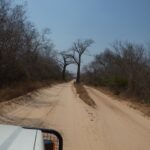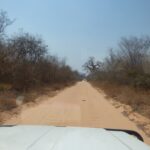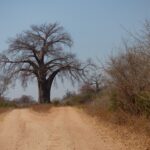In the course of the days, weeks and months anyway only the good memories remain; so we did it again: We drove to the most beautiful national park so far for us (together with Chobe and the Okawango Delta): Mana Pools, a UNESCO World Heritage Site at the Zambezi with a view of Zambia on the other bank side. After a drive of several hours over gravel and sand we got – completely surprising after last year’s loneliness – a bad news: lack of space! Although only at the places directly at the shore of the Zambezi, but exactly there we want, no, we must stay. And finally we made it.
The reason for the more than 100 people spending a weekend in the bush: On the last weekend before the September full moon „Game Counting“ is taking place, volunteers of the NGO „Wildlife Environment Zimbabwe“ are walking (with armed escort) on a precisely defined area of the park on predetermined routes and count all mammals. And the administration of the Zim Parks will extrapolate the figures and know whether, for example, more or less than the previously estimated 30,000 elephants are living here in 2018.
Geblieben aus 2017 sind nur die guten Erinnerungen an den für uns bis jetzt schönsten Nationalpark (neben Chobe und dem Okawango-Delta): Mana Pools, ein UNESCO-Weltnaturerbe am Sambesi mit Blick auf Sambia auf der anderen Uferseite. Also nochmal! Nachdem wir dort im letzten Jahr ziemlich einsam gestanden sind (Gruß an die Behrs aus Göggingen!) empfanden wie es als eine Hiobsbotschaft, dass die Plätze knapp seien. Sind wir am Rhein oder am Sambesi?
Zwar herrschte der Platzmangel nur bei den Plätzen direkt am Ufer des Sambesi, aber genau da wollen, nein, müssen wir hin. Nach längeren Diskussionen klappt’s dann doch noch. Der Grund für die vielen Menschen in der Wildnis: Am letzten Wochenende vor dem September-Vollmond ist „Game Counting“ – über 100 Freiwillige laufen (mit bewaffnetem Begleitschutz) auf einer genau umrissenen Fläche des Parks vorgegebene Routen ab und zählen alle Säugetiere. Und die Verwaltung der Zim-Parks wird die Zahlen hochrechnen und wissen, ob 2018 z.B. mehr oder weniger als die bisher geschätzten 30.000 Elefanten hier leben.



Schreibe einen Kommentar zu Behr Harald Antworten abbrechen